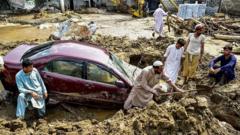In the wake of recent devastating monsoon floods, officials in north-west Pakistan have reported that more than 200 individuals remain unaccounted for in the Buner district. The floods, intensified by landslides, have claimed over 300 lives throughout Pakistan and Pakistan-administered Kashmir, with the majority of the casualties concentrated in the mountainous Khyber Pakhtunkhwa province.
A local representative from the Buner district conveyed to the BBC that approximately 209 people are still missing, although fears persist that this number could escalate. In a grim update, Jehangir Khan, a spokesman for the deputy commissioner's office, shared that eight unidentified bodies have been buried due to the lack of surviving family members to claim them. Additionally, many relatives face challenges in retrieving their loved ones' remains, as critical road infrastructure has been severely damaged by the flooding.
According to a provincial disaster management authority spokesperson, entire villages in neighboring districts have been disrupted, adding to the growing concern. In Shangla district, additional reports indicate that "dozens" more people are unaccounted for.
The recent monsoon rains, which typically occur between June and September and contribute significantly to South Asia's annual precipitation, have been exacerbated by climate change, resulting in more frequent and severe weather events. Torrential rains have also impacted Indian-administered Kashmir, where flash floods recently claimed the lives of at least 60 individuals.
In addition to the 300 confirmed fatalities, the government has declared several areas disaster zones, with forecasts predicting continuous heavy rainfall until August 21. Overall, Pakistan is grappling with one of the most challenging monsoon seasons on record, having reported at least 650 deaths since June.
Northern Pakistan, recognized for its glaciers, faces the threat of accelerated ice melt due to climate change, increasing the susceptibility to landslides and subsequent flooding. While investigations into the precise causes of the recent disasters continue, glaciologists warn that the rapidly thawing ice is a significant factor contributing to the ongoing crisis.


















